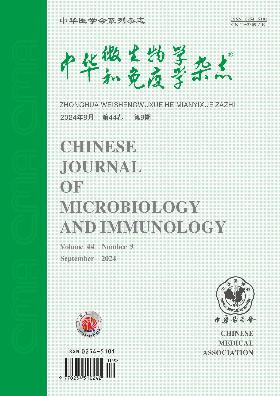疑似无菌性脑膜炎暴发肠病毒的分子检测和序列分析
Q4 Immunology and Microbiology
引用次数: 0
摘要
目的检测和分析浙江省金华市某幼儿园疑似无菌性脑膜炎的肠道病毒。方法从样品中提取病毒核糖核酸,逆转录制备cDNA。用聚合酶链式反应扩增肠道病毒5′-非翻译区(UTR)和VP1基因的部分序列。通过比较VP1基因部分序列之间的同源性来确定病毒的血清型。利用MEGA6构建了VP1部分序列的系统发育树。结果本研究包括7名患者和26名无症状学生。柯萨基病毒A10(CV-A10)在48.5%的学生中检出,回声病毒6(Echo 6)在21.2%的学生中检测到,12.1%的学生可能同时感染这两种病毒。在7名患者中,6人感染了CV-A10,另1人可能有合并感染。根据系统发育分析,本研究检测到的CV-A10菌株与近年来在中国分离的菌株密切相关,包括2015年在厦门和2017年在云南分离的菌株,而Echo 6菌株与2014年在云南、广州和山东分离的菌株在系统发育上有关。结论CV-A10和Echo 6在疑似无菌性脑膜炎病例中检出,与近年来我国出现的菌株有密切的系统发育关系。关键词:无菌性脑膜炎;肠道病毒;柯萨奇病毒A10;回声病毒6本文章由计算机程序翻译,如有差异,请以英文原文为准。
Molecular detection and sequence analysis of enteroviruses isolated from a suspected outbreak of aseptic meningitis
Objective
To detect and analyze enteroviruses causing suspected aseptic meningitis in a kindergarten in Jinhua City, Zhejiang Province.
Methods
Viral RNA was extracted from samples and cDNA was prepared by reverse transcription. PCR was performed to amplify the partial sequences of the 5′-untranslated region (UTR) and VP1 gene of enteroviruses. Serotypes of the viruses were determined by comparing the homology between the partial sequences of VP1 gene. Phylogenetic tree of the partial VP1 sequences was constructed using MEGA6.
Results
This study included seven patients and twenty-six asymptomatic students. Coxsakievirus A10 (CV-A10) was detected in 48.5% of the students and echovirus 6 (Echo 6) in 21.2%. Besides, 12.1% of the students might be co-infected by the two viruses. Among the seven patients, six were infected by CV-A10 and the other one might have co-infection. According to the phylogenetic analysis, CV-A10 strains detected in this study were closely related to those isolated in China in recent years, including the strains isolated in Xiamen in 2015 and Yunnan in 2017, while the Echo 6 strains were phylogenetically related to those isolated in Yunnan, Guangzhou and Shandong in 2014.
Conclusions
CV-A10 and Echo 6 were detected in the cases with suspected aseptic meningitis and had close phylogenetic relationships to the strains appeared in China in recent years.
Key words:
Aseptic meningitis; Enterovirus; Coxsackievirus A10; Echovirus 6
求助全文
通过发布文献求助,成功后即可免费获取论文全文。
去求助
来源期刊

中华微生物学和免疫学杂志
Immunology and Microbiology-Virology
CiteScore
0.50
自引率
0.00%
发文量
6906
期刊介绍:
Chinese Journal of Microbiology and Immunology established in 1981. It is one of the series of journal sponsored by Chinese Medical Association. The aim of this journal is to spread and exchange the scientific achievements and practical experience in order to promote the development of medical microbiology and immunology. Its main contents comprise academic thesis, brief reports, reviews, summaries, news of meetings, book reviews and trends of home and abroad in this field. The distinguishing feature of the journal is to give the priority to the reports on the research of basic theory, and take account of the reports on clinical and practical skills.
 求助内容:
求助内容: 应助结果提醒方式:
应助结果提醒方式:


